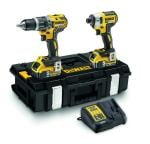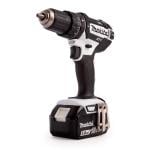How to Make a Dowel Joint and Why
In the world of woodworking, there are many different types of joints that you can use, each of which has its practical advantages. In this article, we’re going to take a particular focus on dowel joints. What is a dowel joint and what is it best utilised for? Read on and discover more.
What Is a Dowel Joint?
First things first, what is a dowel joint? Let’s break it down: a dowel is a cylindrical rod that is typically made from wood, plastic, or metal (though for the sake of this guide we are going to focus on wood). These cylinders or ‘dowels’ are used for holding together the various components of a structure or object.
As dowels are thicker and far sturdier than a screw or a nail, the result is a much more appropriate use in furniture and cabinet making. When joining two pieces of wood together, the dowels are inserted into both pieces of wood, providing a much stronger joint as opposed to simply gluing the two pieces together.
In addition, the dowels are typically dipped in glue before they are inserted into the wood as this invariably creates an even tighter bond between both joining pieces of wood. If you are looking for a durable and accurate joint in woodworking, often a dowel joint will be your best option!
- The wood pieces being joined have pre-drilled holes
- Cylindrical dowels are dipped in glue and slotted into the holes
- The two wood pieces are joined together, with the dowel inserted into both thus strengthening their bond.
What Advantages Does a Dowel Joint Offer?
Now that you have a clearer understanding of what a dowel joint is, what advantages does this type of joint provide?
- Once you know what you are doing dowel joints are easy to make
- Dowel joints provide a significantly neater and flusher finish as opposed to using nails or screws
- There is no need to use screws or nails
- Dowel joints are the strongest type of joint in woodworking.
What Are the Disadvantages of Using a Dowel Joint?
- Steep learning curve for beginners
- Getting the alignment precise can be tricky
- Some people argue that Mortise and Tenon joints provide greater strength.
What Can Dowel Joints Be Used For?
Dowel joints are one of the most commonly used joints in carpentry and woodworking when it comes to joining two or more pieces of wood together. The most common uses of the dowel joint include making furniture, putting shelves together, reinforcing butt joints, making wooden toys, and much more.
In essence, any job that you are working on which requires that you join two pieces of wood together can be done with a dowel joint. Whether or not the dowel joint is the right one for the job depends on what you are doing and what your personal preferences are (again, some people prefer to use mortise or tenon joints).
How Do You Make a Dowel Joint?
Finally, now that you know what dowel joints are, what their pros and cons are, and what they are most commonly used for, let’s move on to how to make a dowel joint by yourself:
Step 1
The first step is to figure out the size of the dowel required and then mark where you are going to make the joint on the wood. You can do this either with a ruler or by drilling a hole in one piece of timber and then using a dowel jig to mark the second piece (this is precisely when executed properly and with careful consideration).
Step 2
Following that you need to drill the holes for the dowel to be inserted.
- You only need to drill as far as the dowel is going to be inserted
- Use a drill bit that is the same size as the dowel you will be using.
Drilling these holes can be done using a cordless or pedestal drill, however, the pedestal drill is always more accurate and typically the best option if you are able.
Step 3
Now that you have your holes pre-drilled you can insert the dowel into one of the pieces of timber and then insert the other piece onto the other end of the dowel, thus joining them together.
- Bond the joint with a strong glue
- Clamps can be used to secure the joint as the glue dries (depending on the size and type of timber being used).
Conclusion
Let’s recap:
- A dowel joint uses cylindrical rods that are inserted into both pieces of wood
- They are easy to make, provide a flusher finish, do not require screws or nails, and are considered the strongest joint in woodworking
- It can be a steep learning curve but when mastered will provide you with an excellent means of joining wood
- Dowel joints are most commonly used in carpentry and woodworking, specifically furniture and cabinet making (among many other functions)








